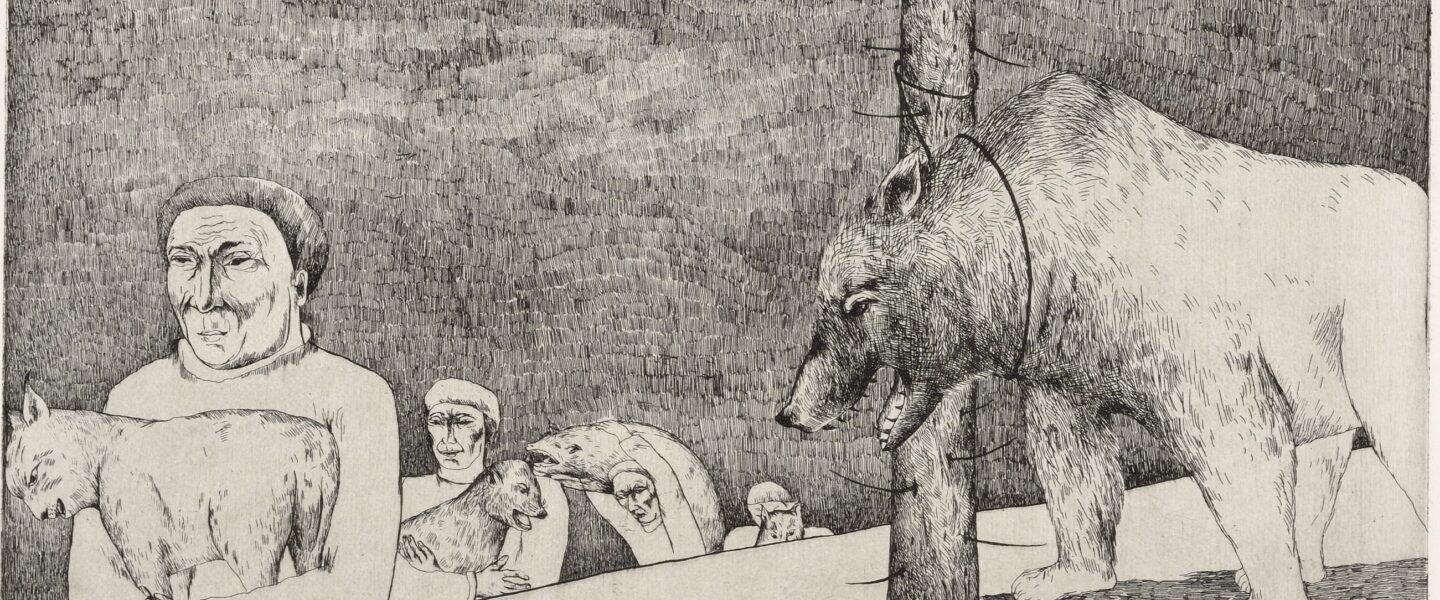
Silvi Liiva. Siber. Taiga. 1973. Art Museum of Estonia
This project will examine Estonia’s relationships with Indigenous peoples and the influence of these relationships on Estonian self-identity, focusing on visual culture, artworks and museum collections. The transdisciplinary project is being carried out in collaboration between the Art Museum of Estonia and the Estonian Academy of Arts.
The exhibition and research project Expedition: Estonians and Indigeneity is closely related to the study of Soviet-era art, one of the Art Museum of Estonia’s research foci which aims to open up new contexts and interpretations of Soviet-period Estonian art, viewing it as a crossroads of cultural and geopolitical spheres of influence. Focusing on artworks, scientific illustrations, films and other visual materials associated with scientific, ethnographic and creative expeditions to different regions of the Russian Empire and the Soviet Union, the project will also contribute to debates and dialogues concerning the decolonisation of Eastern European and Eurasian cultural heritage. At the heart of the exhibition and research project is the expedition as a means of gathering knowledge and establishing power relations. Examining the material collected during various Estonian expeditions over centuries in a new light will also enable us to think through the relationships between Estonians and the Indigenous peoples of Siberia and the Far North.
Although Estonians today see themselves as an Indigenous people, this has not always been the case. Nor has the linguistic connection with Finno-Ugric and Samoyed peoples living hundreds and thousands of miles away always been central to the Estonian identity.
The self-identity of Estonians today has been shaped by the late Soviet expeditions to study Finno-Ugric peoples in Karelia and Siberia, which inspired the films and books by Lennart Meri, the works of Kaljo Põllu and his students at the then State Art Institute (the present-day Estonian Academy of Arts), and many other works that have become central to the modern Estonian culture and identity. But why did so many members of the Estonian cultural elite suddenly take such a keen interest in Indigenous peoples and their cultural heritage in the 1970s and 1980s, and why did they have to look so far afield, essentially in search of their own identities? What spurred them to approach this pursuit with such scholarly rigour? Furthermore, why was the Estonian public in these decades so receptive to this vision of a shared Finno-Ugric cultural heritage and close association with smaller Finno-Ugric peoples?
The project involves the mapping of the materials collected on Finno-Ugric expeditions and the works and (creative) research inspired by these trips. It will also explore the cooperation and conflicts between artists and researchers. In addition, it will examine the contexts in which the voyages took place. How did these Finno-Ugric expeditions relate to the “folklore turn” prevalent elsewhere in Eastern Europe and Central Asia at the time? How did the interest in Indigenous peoples connect to the development of nature conservation, eco-nationalism and the political activism of the 1980s leading to the regaining of Estonian independence.
Project lead: Linda Kaljundi
Team: Linda Kaljundi, Johanna Jolen Kuzmenko, Anastassia Langinen, Elnara Taidre, Ann Mirjam Vaikla, Karin Vicente, Eha Komissarov and Birgit Tohter
Advisers: Svetlana Karm (Estonian National Museum), Piret Koosa (Estonian National Museum), Jaak Prozes (Fenno-Ugria), Marika Alver, Jaanika Vider (University of Vienna / Tallinn University) and Bart Pushaw (University of Tennessee at Chattanooga)
In collaboration with Art Museum of Estonia, Estonian National Museum and Fenno-Ugria
The project examines the collections of the following memory and research institutions: Estonian History Museum, Estonian Literary Museum, Tartu Art Museum, Estonian Academy of Arts Museum, Art Museum of Estonia, Estonian National Museum, Estonian Museum of Applied Arts and Design, University of Tartu Museum, University of Tartu Art Museum, University of Tartu Natural History Museum, Estonian Museum of Natural History, Tallinn University Archaeological Research Collection, TalTech Museum, Kiasma, EMMA and the MO Museum.
Financers: Art Museum of Estonia, Estonian Academy of Arts, Ministry of Culture
Period: 2024-2026
